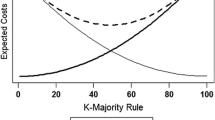Summary
The constitutional process in a democratic society is examined by analysing the role ofdecisive sets in determining the preferences of the entire population. Firstly we consider the properties of sets which emerge from a group preference function satisfying the four conditions set by Arrow. Secondly we reverse the analysis and define first a set of desirable properties of the decisive sets. We then prove that under these fairly general conditions a group preference function exists for which all four of Arrow's conditions are simultaneously satisfied.
Similar content being viewed by others
References
Arrow, K.J.,Social Choice and Individual Values, 2nd edition, New York, 1963.
Bell, J.L. and A.B. Solomon,Models and Ultraproducts: An Introduction, Amsterdam, 1969.
Booth, D., “Ultrafilters on Countable Sets,”Annals of Mathematical Logic, 11 (1970).
Bourbaki, N.,General Topology, Paris, 1966.
Comfort, W.W. and S. Negrepontis,The Theory of Ultrafilters, Berlin-New York, 1974.
Fishburn, P.C., “Arrow's Impossibility Theorem: Concise Proof and Infinite Voters,”Journal of Economic Theory, II (1970), pp. 103–106.
Hansson, B., “The Existence of Group Preference Functions,”Public Choice, XXVIII (1976), pp. 89–97.
Kirman, A.P. and D. Sondermann, “Arrow's Theorem, Many Agents and Invisible Dictators,” Journal of Economic Theory, V (1972), pp. 267–277.
Salles, M., “A General Possibility Theorem for Group Decision Rules with ParetoTransitivity,rd Journal of Economic Theory, XI (1975), pp. 110–118.
Saposnic, R., “On Transitivity of the Social Preference Relation under Simple Majority Rule,” Journal of Economic Theory, X (1975), pp. 1–7.
Sen, A.K.,Collective Choice and Social Welfare, New York, 1970.
Sen, A.K., “Quasi-Transitivity, Rational Choice and Collective Decisions,”Review of Economic Studies, XXXVI (1969).
Wolf, R.P., InDefense of Anarchy, New York, 1970.
Author information
Authors and Affiliations
Additional information
I wish to thank Peter Newman, an anonymous referee and the editor of this Journal for helpful comments.
Rights and permissions
About this article
Cite this article
Bigman, D. Decisive sets, majority voting and the existence of a group preference function. De Economist 129, 241–252 (1981). https://doi.org/10.1007/BF01705810
Issue Date:
DOI: https://doi.org/10.1007/BF01705810




